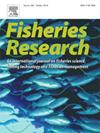Broadband characteristics of Pacific herring (Clupea pallasii) and Pacific chub mackerel (Scomber japonicus) target strength identified using the tether method
IF 2.2
2区 农林科学
Q2 FISHERIES
引用次数: 0
Abstract
Target strength (TS) is essential for acoustic fish biomass estimation. Traditional narrowband surveys, which are constrained by single-frequency TS measurements, limit species identification. In contrast, broadband technology, which utilises continuous frequency ranges, enhances differentiation through TS frequency response. The aim of this study was to investigate whether the structural differences in swim bladders between physostomous and physoclistous fish produce distinguishable TS characteristics. Pacific herring (Clupea pallasii) and Pacific chub mackerel (Scomber japonicus) were selected to represent physostomous and physoclistous species, respectively. TS measurements were conducted using the tether method in freshwater and seawater tanks, employing calibrated split-beam quantitative echo sounders (Simrad EK80 scientific echosounder system) within the range of 45–260 kHz. After the acoustic measurements, the theoretical TS estimated by the Kirchhoff ray mode model was compared with the measured results. The maximum TScm increased with increasing L/λ (ratio of length (L) to wavelength (λ)) for both species. The tilt angle distribution was assumed to be represented by a normal distribution (mean value: −5°, standard deviation: 15°) regarding average TScm. Pacific herring showed an overall decreasing trend, whereas Pacific chub mackerel showed no significant trend. At L/λ < 4.5, significant differences were observed in maximum and average TScm and L/λ characteristics, with Pacific herring exhibiting a marked decrease and Pacific chub mackerel showing a slight increase. These results may improve the accuracy of fishery resource assessments of these two species, assist in their identification, and provide a reference for differentiating between physostomous and physoclistous fish.
求助全文
约1分钟内获得全文
求助全文
来源期刊

Fisheries Research
农林科学-渔业
CiteScore
4.50
自引率
16.70%
发文量
294
审稿时长
15 weeks
期刊介绍:
This journal provides an international forum for the publication of papers in the areas of fisheries science, fishing technology, fisheries management and relevant socio-economics. The scope covers fisheries in salt, brackish and freshwater systems, and all aspects of associated ecology, environmental aspects of fisheries, and economics. Both theoretical and practical papers are acceptable, including laboratory and field experimental studies relevant to fisheries. Papers on the conservation of exploitable living resources are welcome. Review and Viewpoint articles are also published. As the specified areas inevitably impinge on and interrelate with each other, the approach of the journal is multidisciplinary, and authors are encouraged to emphasise the relevance of their own work to that of other disciplines. The journal is intended for fisheries scientists, biological oceanographers, gear technologists, economists, managers, administrators, policy makers and legislators.
 求助内容:
求助内容: 应助结果提醒方式:
应助结果提醒方式:


